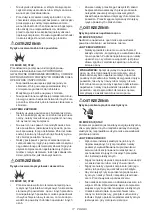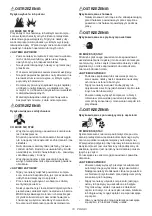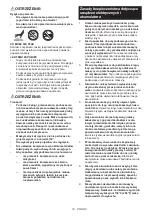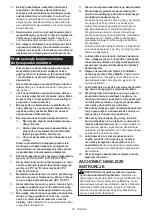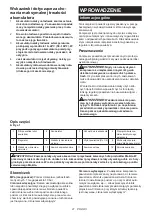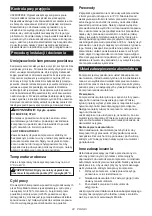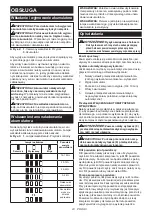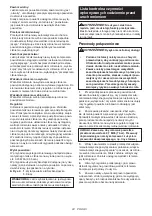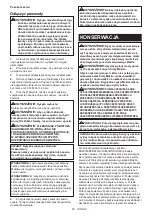
10 ENGLISH
OPERATION
Installing or removing battery cartridge
CAUTION:
Always switch off the tool before
installing or removing of the battery cartridge.
CAUTION:
Hold the tool and the battery cartridge
firmly when installing or removing battery cartridge.
Failure to hold the tool and the battery cartridge firmly may
cause them to slip off your hands and result in damage to
the tool and battery cartridge and a personal injury.
►
Fig.2:
1.
Red indicator
2.
Button
3.
Battery cartridge
To remove the battery cartridge, slide it from the tool
while sliding the button on the front of the cartridge.
To install the battery cartridge, align the tongue on the
battery cartridge with the groove in the housing and slip
it into place. Insert it all the way until it locks in place
with a little click. If you can see the red indicator as
shown in the figure, it is not locked completely.
CAUTION:
Always install the battery cartridge
fully until the red indicator cannot be seen.
If not,
it may accidentally fall out of the tool, causing injury to
you or someone around you.
CAUTION:
Do not install the battery cartridge
forcibly.
If the cartridge does not slide in easily, it is
not being inserted correctly.
Indicating the remaining battery capacity
Press the check button on the battery cartridge to indi-
cate the remaining battery capacity. The indicator lamps
light up for a few seconds.
►
Fig.3:
1.
Indicator lamps
2.
Check button
Indicator lamps
Remaining
capacity
Lighted
Off
Blinking
75% to 100%
50% to 75%
25% to 50%
0% to 25%
Charge the
battery.
The battery
may have
malfunctioned.
NOTE:
Depending on the conditions of use and the
ambient temperature, the indication may differ slightly
from the actual capacity.
NOTE:
The first (far left) indicator lamp will blink when
the battery protection system works.
Description of operation
WARNING:
Risk of Noise
•
Wear hearing protection to protect your
ears against exhaust noise and noise during
operation.
Drain valve:
The drain valve is located at the bottom of the air tank
and is used to drain condensation at the end of each
use.
Automatic shut off system:
If the compressor automatically shuts off before reach
-
ing its normal cutoff pressure :
1. Turn the On/Auto-Off switch to "Off" position.
2. Remove the battery cartridge.
3. Wait until the compressor cools down. (about 10
min.)
4. Install the battery cartridge.
5. Turn the On/Auto-Off switch to "On/Auto" position.
ON/AUTO - OFF switch:
Turn this switch to on (I) position to provide automatic
power to the pressure switch and to off (0) position to
remove power when finished using the compressor or
when compressor will be left unattended.
WARNING:
Always turn off (0) the On/Auto-
Off switch when not in use.
CAUTION:
When carrying the tool, turn off (0)
the On/Auto-Off switch.
Air filter (Air intake):
Keep the air filter clean at all times. Do not operate the
compressor with the air filter removed. The compressor
does not operate at full capacity if the air filter is dirty.
Before using the compressor, always check the air filter
if it is clean. If not, clean the air filter or replace the filter
element.
Air compressor pump:
To compress air, the piston moves up and down in the
cylinder. On the down stroke, air is drawn in through the
air intake valve. The exhaust valve remains closed.
On the upstroke of the piston, air is compressed. The
intake valve closes and compressed air is forced out
through the exhaust valve, through the outlet tube,
through the check valve and into the air tank. Useable
air is not available until the compressor has raised the
air tank pressure above that required at the air outlet.
Check valve:
When the air compressor is operating, the check valve
is “open”, allowing compressed air to enter the air tank.
When the air compressor reaches “cut-out” pressure,
the check valve “closes”, allowing air pressure to remain
inside the air tank.
Pressure switch:
The pressure switch automatically starts the motor
when the air tank pressure drops to the factory set
“cut-in” pressure. It stops the motor when the air tank
pressure reaches the factory set “cut-out” pressure.

















